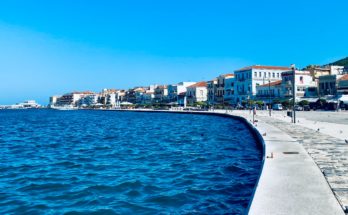Introduction to Greece
Greece, the southernmost country on the European mainland, has always held a special place in our hearts. Its rich history, vibrant culture, and stunning landscapes make it a top destination for holiday makers worldwide.
Our Love for Greece
We are continually enchanted by the beauty and allure of Greece. Its timeless appeal can be attributed to its ancient historical sites, pristine beaches, and culinary delights. From the grandeur of the Parthenon in Athens to the spectacular sunsets in Santorini, Greece never fails to impress with its variety and charm.
Immersing ourselves in the Greek culture, savouring the unique flavours of Greek cuisine, and exploring the historic landmarks have given us unforgettable memories. But what stands out the most is the warm hospitality of its people, making every Greece visit truly special.
Overview of Greece’s Cities
Greece is not just about its popular islands and beaches. The country’s cities, each with its distinctive character and charm, are equally captivating.
Athens, the capital, is a mix of ancient and modern, where historic sites coexist with vibrant city life. Thessaloniki, the cultural heart of Greece, is known for its festivals, events, and vibrant nightlife. Santorini, with its stunning sunsets and iconic blue-domed churches, is a vision of paradise. Heraklion, the capital of Crete, offers a blend of modernity, history, and nature. Finally, Patras, often referred to as the ‘Gateway to the West’, is a bustling port city with a rich cultural scene.
Each of these cities has its unique draw and the best times to visit vary. Our objective is to guide you through the myriad of possibilities and help you plan your perfect Greece vacation.
As we journey through the various Greece cities, we’ll share our insights on the best times to visit, the must-see attractions, and the unique features that make each city a gem in its own right. So, join us as we embark on this exciting exploration of Greece’s hidden treasures.
Athens: The Capital City
The Historical Significance of Athens
As we delve into the heart of Greece, we find ourselves in the vibrant and historic city of Athens. Known as the cradle of Western civilisation, Athens is a city that perfectly blends the old and the new. The city’s historical significance is evident in its stunning landmarks and architectural marvels that date back to the 5th century BC.
The Acropolis, an ancient citadel perched high above the city, is home to several historically significant structures such as the Parthenon, Erechtheion, and Temple of Athena Nike. Visiting these remarkable sites gives us a glimpse into Greece’s rich history and the incredible architectural prowess of the Ancient Greeks. For a deeper understanding of Athens’ historical significance, we recommend visiting our article on Greece history.
The Perfect Weather to Visit Athens
When it comes to choosing the perfect time to visit the capital among other Greece cities, it’s crucial to consider the weather. In Athens, the weather is typically Mediterranean, characterised by warm summers and mild winters. The best time to visit Athens is arguably during spring (April to June) and autumn (September to November).
During these periods, the weather is pleasant with daytime temperatures ranging from 20°C to 28°C, making it ideal for sightseeing and exploring the city’s historical sites. The summer months (July and August) can be quite hot, with temperatures often soaring above 30°C.
Here’s a quick look at the average temperatures in Athens throughout the year:
| Month | Average Temperature (°C) |
|---|---|
| January | 10 |
| February | 11 |
| March | 14 |
| April | 18 |
| May | 23 |
| June | 28 |
| July | 31 |
| August | 31 |
| September | 26 |
| October | 20 |
| November | 15 |
| December | 12 |
For more detailed information about Greece’s weather, you can check out our Greece weather guide. Remember, planning your visit during the right season can significantly enhance your experience and make your Greece vacation truly unforgettable.
Thessaloniki: The Cultural Heart
Thessaloniki, Greece’s second-largest city, is a place where history and culture blend seamlessly with the vibrancy of modern life. Its captivating charm offers a unique experience to visitors.
Unveiling the Beauty of Thessaloniki
Thessaloniki is a city that’s rich in history and culture, offering something for everyone. From its well-preserved historical sites to its lively food scene, there’s an endless array of attractions to discover. Visit the city’s landmark, the White Tower, for an amazing view of Thessaloniki and its surrounding landscapes. Wander through the Ano Poli (Upper Town), where you’ll find traditional houses and Byzantine-era walls. Delve into the city’s history at the Archaeological Museum of Thessaloniki. And don’t miss the Rotunda of Galerius, a massive round building that has served various purposes over the centuries, from mausoleum to mosque, and now a museum.
But Thessaloniki isn’t just about the past. It’s a city that’s alive with a vibrant arts scene, bustling markets, stylish boutiques, and an exciting nightlife. And of course, the food in Thessaloniki is a delight for the senses. With a rich culinary tradition, the city offers an array of delicious dishes to try. For more on Greek cuisine, check out our article on Greece food.
The Ideal Time to Explore Thessaloniki
Deciding when to visit one of the beautiful Greece cities like Thessaloniki depends largely on the kind of experience you’re after.
For the most pleasant weather, we recommend visiting in the spring (April to June) or autumn (September to November). During these periods, the city experiences mild temperatures and fewer crowds, making it an ideal time for sightseeing and outdoor activities.
| Month | Average Temperature (°C) |
|---|---|
| April | 16 |
| May | 20 |
| June | 25 |
| September | 25 |
| October | 20 |
| November | 15 |
The summer (July and August) can get quite hot, with temperatures often soaring above 30°C. However, this is also when Thessaloniki is at its most vibrant, with numerous festivals and events taking place.
The winter months (December to February) are cooler, with temperatures often dropping to single digits. However, this is a great time to enjoy the city’s indoor attractions, such as its museums and galleries.
Regardless of when you choose to visit, Thessaloniki is sure to captivate you with its charm and vibrancy. For more information on the country’s climate, refer to our guide on Greece weather.
Santorini: The Island Paradise
As we travel through Greece, we can’t overlook the stunning island of Santorini, one of the most iconic of all Greece cities. This island paradise is famous for its striking blue-domed churches, steep cliffs, and awe-inspiring sunsets.
Capturing the Magic of Santorini
Santorini is a true postcard destination. Its white-washed buildings and cobalt blue domes cascade down the cliffs, providing a striking contrast against the azure waters of the Aegean Sea. This island offers a unique blend of natural beauty, rich history, and vibrant culture that captivates every traveller.
One of the key attractions in Santorini is the caldera, a large sea-filled crater formed by a volcanic eruption thousands of years ago. The cliffs surrounding the caldera offer stunning panoramic views, especially during sunset. Don’t miss a chance to explore the quaint villages of Fira and Oia, which are known for their traditional Cycladic architecture and breathtaking vistas.
Santorini also boasts some of the best beaches in Greece, each with its unique charm. From the black sand beach of Perissa to the red beach of Akrotiri, these distinct landscapes add to the island’s allure.
The Best Time to Experience Santorini
The best time to visit Santorini depends on what you’re looking to get out of your Greece vacation. If you’re a sun-seeker, the months from June to September are ideal as they offer warm temperatures and minimal rainfall. However, these are also the busiest months in terms of tourism, so expect larger crowds.
| Month | Average High (°C) | Average Low (°C) | Rainfall (mm) |
|---|---|---|---|
| June | 28 | 21 | 6 |
| July | 30 | 23 | 2 |
| August | 30 | 23 | 6 |
| September | 28 | 21 | 14 |
For those who prefer milder weather and fewer crowds, the shoulder months of April, May, October, and November are an excellent choice. During these months, the weather is pleasant, and you can explore the island’s attractions at a leisurely pace.
| Month | Average High (°C) | Average Low (°C) | Rainfall (mm) |
|---|---|---|---|
| April | 19 | 12 | 20 |
| May | 23 | 16 | 10 |
| October | 23 | 16 | 52 |
| November | 19 | 12 | 58 |
No matter when you decide to visit, Santorini’s enchanting beauty, combined with the relaxed island vibe, will surely make for an unforgettable experience. As always, ensure you check the Greece weather before planning your trip for the most accurate and up-to-date information.
Heraklion: Crete’s Vibrant Capital
Next on our journey through the enchanting Greece cities, we head to Crete’s vibrant capital, Heraklion. Known for its rich history, bustling markets, and stunning coastline, Heraklion is a must-visit on any Greek adventure.
The Charms of Heraklion
Heraklion is a city that beautifully marries the old and the new. The medieval fortress of Koules, the ancient ruins of Knossos, and the Heraklion Archaeological Museum are just some of the historical treasures that bear testament to the city’s rich history. Read more about Greece history to further appreciate what this city has to offer.
But Heraklion isn’t just about history. This vibrant city is replete with bustling markets where you can find everything from fresh local produce to unique handmade souvenirs. The city’s lively nightlife scene, delightful Greece food, and spectacular Greece beaches are also reasons why many tourists are drawn to Heraklion.
The Optimal Weather for Visiting Heraklion
When planning your visit to Heraklion, it’s essential to consider the weather to make the most of your trip. Like most of Greece, Heraklion enjoys a Mediterranean climate, with warm, dry summers and mild, wet winters.
Below is a table showing the average temperatures and rainfall in Heraklion throughout the year.
| Month | Average High (°C) | Average Low (°C) | Average Rainfall (mm) |
|---|---|---|---|
| January | 15 | 9 | 80 |
| February | 15 | 9 | 70 |
| March | 17 | 10 | 40 |
| April | 20 | 12 | 20 |
| May | 24 | 15 | 10 |
| June | 28 | 19 | 5 |
| July | 30 | 22 | 0 |
| August | 30 | 22 | 0 |
| September | 28 | 19 | 10 |
| October | 24 | 16 | 60 |
| November | 20 | 13 | 80 |
| December | 16 | 10 | 90 |
The best time to visit Heraklion is during the late spring (May to June) or early autumn (September to October). The weather during these months is typically warm and pleasant, making it perfect for exploring the city’s historical sites and relaxing on its beautiful beaches.
Be sure to check our detailed guide on Greece weather to help you plan your trip.
No matter what time of year you choose to visit, you’re sure to fall in love with Heraklion. From its rich history to its vibrant modern life, this city is one of the hidden gems of Greece that deserves to be explored.
Patras: The Gateway to the West
Patras, often referred to as ‘The Gateway to the West’ due to its position as a bustling port city, holds a unique charm that sets it apart from other Greece cities.
Discovering Patras
Patras is a beautiful blend of vibrant city life and rich cultural heritage. Its bustling streets are lined with modern shops, cafes, and restaurants, while its historical district offers a captivating peek into Greece’s past.
The city is home to the famous Patras Carnival, one of the biggest and most colourful events in all of Greece. The festivities offer a unique glimpse into Greece culture and are a must-see for any visitor to the city.
But the beauty of Patras extends beyond its cultural events. The city’s stunning beaches are some of the finest among the Greece beaches, offering a perfect spot for relaxation after a day of exploring.
Patras is also home to several remarkable landmarks, including the iconic Patras Castle and the spectacular Saint Andrew’s Cathedral. The city’s rich Greece history is evident in its well-preserved architecture and numerous archaeological sites, making it a dream destination for history enthusiasts.
Choosing the Perfect Time to Visit Patras
The best time to visit Patras depends largely on your preferences. If you’re looking to experience the city’s vibrant culture in full swing, plan your Greece vacation around the Patras Carnival, which typically takes place in February or March.
For those interested in a beach holiday, the best time to visit is during the summer months (June to August) when the weather is at its warmest. However, do note that these months also see the most tourists, so expect larger crowds at popular attractions.
The table below provides a snapshot of the typical weather conditions in Patras throughout the year:
| Month | Average High (°C) | Average Low (°C) |
|---|---|---|
| January | 15 | 5 |
| February | 15 | 5 |
| March | 18 | 7 |
| April | 21 | 10 |
| May | 26 | 14 |
| June | 30 | 18 |
| July | 33 | 21 |
| August | 33 | 21 |
| September | 29 | 18 |
| October | 24 | 13 |
| November | 19 | 9 |
| December | 16 | 6 |
For more detailed information about the weather in Greece, visit our page on Greece weather.
Whether you’re a history buff, a culture enthusiast, or a beach lover, Patras promises a memorable holiday experience. So, pack your bags and get ready to explore this vibrant city, one of the many stunning gems among the Greece cities.
Exploring Greece’s Hidden Gems
While the popular Greece cities like Athens and Santorini are truly enchanting, there’s a whole different charm to exploring the lesser-known destinations in Greece. If you’re someone who enjoys discovering off-the-beaten-path locations, these hidden gems are sure to captivate your heart.
Lesser-Known Cities to Visit
Among the less frequented cities, Nafplio, a seaport town in the Peloponnese, is a true gem. Its cobblestone streets, Venetian homes, and the Palamidi Fortress are a delight for history enthusiasts.
Moving northwards, Ioannina, sitting by the lake Pamvotis, offers a unique blend of natural beauty and rich history. Visit the Ioannina Castle, take a boat to the island in the middle of the lake, and enjoy the local cuisine, which is a treat for Greece food lovers.
On the island of Lesbos, the city of Mytilene is worth a visit for its traditional houses, Byzantine castle, and the Theophilos Museum, showcasing the work of the local folk painter.
| City | Key Highlight |
|---|---|
| Nafplio | Palamidi Fortress |
| Ioannina | Ioannina Castle |
| Mytilene | Theophilos Museum |
Timing Your Visit for Optimal Weather
The best time to visit these hidden gems is during the shoulder seasons of spring (April to June) and autumn (September to November). During these months, the weather is mild, the crowds are thinner, and the Greece weather is generally pleasant for sightseeing.
In Nafplio, the average temperature ranges from 15°C in April to 30°C in June, and from 29°C in September to 19°C in November. Ioannina has a similar climate, with temperatures ranging from 13°C to 28°C in spring and 28°C to 15°C in autumn. Mytilene, being an island city, has slightly warmer temperatures, with averages ranging from 16°C to 30°C in spring and 29°C to 20°C in autumn.
| City | Spring Average Temp (°C) | Autumn Average Temp (°C) |
|---|---|---|
| Nafplio | 15 – 30 | 29 – 19 |
| Ioannina | 13 – 28 | 28 – 15 |
| Mytilene | 16 – 30 | 29 – 20 |
In the end, the best time to visit depends on your personal preferences and what you want to see and do. Whether you’re exploring historical sites, tasting local cuisine, or simply soaking up the sun on the Greece beaches, these lesser-known cities provide an authentic Greece experience.



